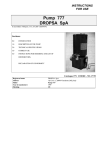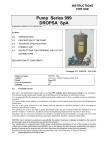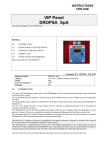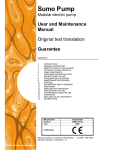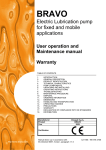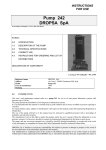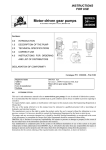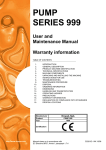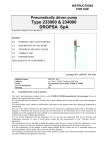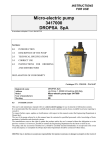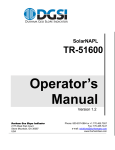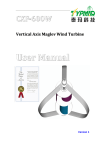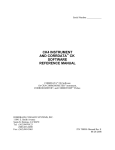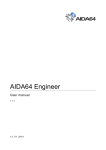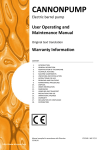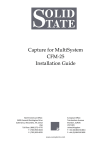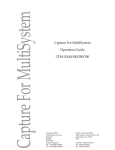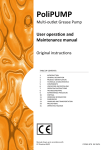Download Pump 777 DROPSA SpA
Transcript
INSTRUCTIONS FOR USE Pump 777 DROPSA SpA In accordance with para. 1.7.4, of I, Dir CEE 89/392 Sections: 0.0 INTRODUCTION 1.0 DESCRIPTION OF THE PUMP 2.0 TECHNICAL SPECIFICATIONS 3.0 CORRECT USE 4.0 INSTRUCTIONS FOR ORDERING AND LIST OF DISTRIBUTORS. DECLARATION OF CONFORMITY Catalogue P/N C2018IE - Wk 17/99 Registered name Address Model Year of manufacture Marking DROPSA SpA via Croce 1, 20090 Vimodrone (MI), Italy Pump 777 1999 CE 0.0 INTRODUCTION This user’s and maintenance manual refers to pump 777, for use in lubrication systems for oil and grease, including high pressure systems (up to 500 bar). The use of this pump permits the distribution of oil and grease in lubrication systems at pressures up to 500 bar. It is recommended that this manual is carefully kept in good condition and is always available to persons requiring to consult it. To request further copies, updates or clarifications with respect to this manual contact the Engineering Department at Dropsa SpA. The use of the pump referred to in this manual must be entrusted to qualified personnel with a knowledge of hydraulics and electrical systems. The manufacturer reserves the right to update the product and/or the user’s manual without the obligation to revise previous versions. It is however, possible to contact the Engineering Department for the latest revision in use. The pump, and any accessories mounted on it, should be carefully checked immediately on receipt and in the event of any discrepancy or complaint the Dropsa SpA Sales department should be contacted without delay. DROPSA S.p.A. declines to accept any responsibility for injuries to persons or damage to property in the event of the non-observance of the information presented in this manual. Any modification to component parts of the system or the different destination of use of this system or its parts without prior written authorisation from DROPSA S.p.A. will absolve the latter from any responsibility for injury or damage to persons and/or property and will release them from all obligations arising from the guarantee. Instructions for the correct ordering of the required model, and a list of importers, is shown in Section 4. 1.0 DESCRIPTION OF THE PUMP The 777 series lubrication pumps can be adapted to meet many requirements without mechanical modifications, even where the pump is already installed. By choosing from among a range of perfectly compatible and easily assembled components, variations can be made to the pressure, the quantities of lubricant delivered, the type of lubricant or the type of distribution. This construction technique is based essentially on the following modules: • Motor and reduction unit • Dual element pump • Tank • Valves and output assembly (reverser, etc.) The supporting structure is common to all versions, with the dual pumping element constituting the essential module. From one pump assembly there are provided two separate outlets for the lubricant, protected by double non-return valves. The two ways can be connected together to double the quantity of lubricant on one line only or they can be employed separately on two independently controlled single line circuits. On the same support structure it is possible to mount types of tank with different volumes suitable for oil or grease with paddle units and level indicators. The control of the motor is obtained by use of normal electrical equipment which provides for the reversing of the direction of rotation and the execution of the programmed cycles. The motor-driven pump 777 is totally protected from the external environment and can operate without difficulties in the severest environmental conditions. The pump is composed of a series of components with the following characteristics: CHARACTERISTICS PUMP 777 Pump capacity cc/min Maximum pressure in bars Tank capacity in litres max. 130 C2018IE - Pump 777 - Rev. 0 500 (7350 psi) 10 - 30 - 100 Jan. 1999 Page 2 By-pass rating (with internal regulating screw) Minimum operating time (sec) Mineral lubricant characteristics at working temperature Working temperature Motor Absorbed Power Grade of protection Insulation 300 bar (4410 psi) 24 (minimum pause time 96 sec) CSt 15 - 1500 (oil) max NLGI 2 (grease) - 5 °C ÷ + 40 °C (+23°F ÷ +104°F) Three phase 220 – 380 V 50 Hz – 4 pole 1500 rpm 370 W On request 750 W IP55 Class F It is also possible to supply the pump with a mechanical or hydraulic reverser. 1.1 Pump assembly (Code 291415) The assembly is made up of two identical pump units, each one having two identically sized pistons. The pistons are in ground and lapped hardened steel; one of these acts as the pump and the other as the control valve. The pump housing is in steel; the ports are bored and lapped; the drive shaft is in hardened and ground steel. 1.2 Reduction unit The reduction unit casing is in aluminium. The drive shaft with worm screw is hardened and ground. The worm wheel is in hardened steel. Both the drive shaft and the worm wheel shaft are fitted with ball bearings. The free wheels used on this pump are among the best brands on the market. Attention: lubrication of the reduction unit in dual line grease systems is ensured by the return of grease into the pump via port (F). Where the pump is utilised for grease on a single line system (where there is no return to the pump) it would be advisable to provide a point for lubrication of the reduction unit through port (F). Obviously, in an oil system this precaution is not necessary as all parts of the reduction gears are effectively in an oil bath. 1.3 Reverser 1.3.1 Electro-mechanical reverser When the pump is installed in a dual line system it is necessary to utilise this reverser. The mounting is already prepared with fixing holes to accept this device, whose functioning is tied to the use of the reverser and lubrication cycle electrical control equipment. The main parts of the device are: • the reverser in steel with a hardened, ground and lapped piston; • cam assembly and freewheel in hardened steel; • two watertight micro-switches which control the reversing and the exact positioning of the piston. The front of the reverser is prepared with a hole for connecting a manometer. OPERATION AND ADJUSTMENT OF THE CONTACTS One of the original features of this motor-driven pump is that of utilising the motor both for the movement of the pistons of the pump unit and for the reversing of the line. The motor, after the required pause between one lubrication and the next, is started by turning the worm screw, the worm wheel and the pump assembly. The worm wheel has an external appendix on which is mounted a cam for the reversing of the line. When the motor drives the pump, the worm wheel shaft rotates anticlockwise for as long as the cam, for C2018IE - Pump 777 - Rev. 0 Jan. 1999 Page 3 the effect of the free wheel, remains stationary. The pump feeds line 1 and, after having filled the tubing and the valves, will act on the contact of the end of line pressure switch which, through the electrical equipment, provokes the inversion of the motor direction. This reversing will result in the reversing of the rotation of the cam shaft, while the pump will stop instantaneously; also the pump drive shaft is attached with the free wheel. The line reversing cam will rotate rapidly to the closure of the microswitch (32) contact, the motor will reverse direction returning to drive the pump to feed line 2. The closing of the line 2 pressure switch contact will provoke a further inversion of the initial rotation by actuating the second microswitch closing contact. (32). The closing of this contact will reverse the rotation of the motor for a period of approx. one second; this will conclude the lubrication cycle. 1.3.2 Hydraulic reverser The lubricant which comes from the pump through the central part of piston A (Fig.1) is distributed into chamber C, entering into line 1 and tending to position piston B toward the left. When the set pressure of spring M1 is reached, the small piston S1 of the sequence valve lifts and permits the lubricant to enter into chamber D. Piston A is moved toward the left; lubricant is sent into chamber E, the small piston B is moved to the right (Fig.2) and the lubricant enters into line 2 while line 1 discharges (return). When the set pressure of spring M2 is reached, lubricant is sent into chambers C and F; pistons A and B invert their positions and the delivery is again directed to line 1. The necessary reversing pressures are attained by regulating the loading of springs M1 – M2. 1.4 Pressure Control Valve Code 291162 Pressure 50 ÷ 500 bar (735 ÷ 7350 psi) Description 291391 Pressure 20 ÷ 250 bar (294 ÷ 3675 psi) Also these valves can be easily disassembled for inspections. They are adjustable and have the function of regulating the pressure. It is important to keep in mind that the inversion of the lines is controlled by the closing of the pressure switch contacts. The regulation of the pressure switch must involve an operating pressure which is always less than the maximum pressure controlled by this valve. 1.5 Flow regulator (Code 3293060) The flow regulator serves to regulate the quantity of lubricant delivered at each pump cycle. It can easily be set between * 14.5 - 65 cc./1 by turning the rear nuts code 3235097 clockwise or anticlockwise. It is also applicable to a single pump element. C2018IE - Pump 777 - Rev. 0 Jan. 1999 Page 4 1.6 Minimum and maximum level indicators 1.6.1 Indicator for grease Minimum level Code 291244 For 10 kg tank. (22 lb) Description 291220 For 30 kg tank. (66.1 lb) 291210 For 100 kg tank. (220.4 lb) This device is used when it is wished to control the minimum level of the tank where the use of a paddle unit is provided for grease. The operation of the minimum level contact occurs through the reaction of the blade with the shaft (7) opposing the grease moved by the arm of the moving paddle. The minimum level contact serves to illuminate the warning lamp on the electrical panel and additionally for any command signal to an automatic tank refilling pump. Maximum level This indicator must always be provided when it is wished to incorporate automatic tank refilling. The refilling pump is automatically set in operation when the grease in the tank falls below the minimum level actuating the respective electrical contact. To avoid the refilling pump continuing to deliver lubricant beyond the capacity limit of the tank it is essential to incorporate a maximum level microswitch with which to stop the pump. 1.6.2 Minimum and maximum level indicators for oil Code Description 291155 Maximum level indicator 291275 Minimum level indicator for 30 l tanks. 291276 Minimum level indicator for 10 l tanks. 291291 Minimum level indicator for 100 l tanks. Two magnetic contact indicators are incorporated for the control of the minimum and maximum oil levels. The cover is suitably prepared for receiving these devices; the output cables can be run through a single sheathing for connecting to the electrical control equipment. 1.7 Paddle unit for grease Tanks are provided in three different capacities: 10, 30 and 100 kg. (22, 66.1 , 220.4 lb). There is a “paddle unit for grease” assembly for each capacity. The pump mounting, which also supports the tank, is prepared for receiving this assembly. To install the paddle unit when the pump is already mounted, it is sufficient to remove the tank. In addition to the perforated disk, which supports the paddle unit assembly, there is also provided, on the upper part, a steel mesh filter disk with 0.5 mm holes. In this way the pump is protected from any foreign bodies that could be encountered even in grease from sealed drums or which may inadvertently fall into the tank during refilling from above. Where the blade is not able to push very thick (above grade 3) grease through the holes in the filter mesh, or when working at very low temperatures, the filter disk can be removed. However, care must then be taken to ensure that refilling is carried out using a suitable manual or pneumatic pump and a filter, code 3130009. Refilling of the tank by hand is not recommended. C2018IE - Pump 777 - Rev. 0 Jan. 1999 Page 5 1.8 Manometer Code 20550 1000 bar (14700 psi) 1.9 Description Only one version is provided Operating control The pump 777 can be supplied with an electrical control panel with indicators for on/off, minimum and maximum lubricant levels, pressurisation of the two lines, alarms, lubrication cycle not respected and power on. In addition there is a selector for continuous operation or timed by the system, and two timers for regulating the pause and lubrication times. 1.10 Electrical equipment “DROPSA” electrical equipment has been designed with the aim of supplying a system complete with all the controls necessary for automatic operation and controlled by centralised lubrication system safety signalling. 1.10.1 Equipment for dual line systems This equipment is enclosed in a robust metal cabinet with IP 55 grade protection, and is available in different versions for the command and control of the 777 Series pumps with electromechanical or hydraulic reversers. It is equipped with two yellow warning lamps (B and G) for signalling minimum and maximum lubricant levels, two white lamps (C and D) which signal the pressurisation of respectively lines 1 and 2 and a red alarm warning lamp (F) which illuminates when the lubrication cycle is not effected in the time set on the cycle control timer. A green lamp (A) indicates power on, while a blue lamp (E) indicates the functioning of the pump. A reset button (H) resets the system after an alarm and a selector (I) permits the selecting of either continuous operation or timed by the system. Two multi-scale electromechanical timers facilitate the simple and rapid setting of the pause and lubrication times (working time of the pump). The minimum and maximum work and pause times and the variations depend on the type of scale set. The pause timer is equipped with a mechanical lock device which, in the event of a power off during the pause, locks the timer in the position reached. Code 1641295 1638489 1638488 1638540 1.10.2 Description For 777 pumps with electromechanical reverser For 777 pumps with hydraulic reverser As the 1638489 but c/w acoustic alarm signal As the 1638489 but in a flameproof version Equipment for progressive systems This equipment is enclosed in a robust metal cabinet with IP 55 grade protection, and is equipped with an electronic timer for the setting of the pause time and an electromechanical timer for setting the lubrication time (working time). The maximum standard pause time is 1 hour with variations of 2.5 min. By specifying when placing the order or by acting on the electrical jumper situated in the timer it is possible to obtain a maximum pause time of 8 hours (20 min. variations) or 24 hours (1 hour variations). The working time can be regulated from 0 to 12 minutes with variations of 12 seconds. It is equipped with alarm warning lights for lack of lubricant and minimum level in the tank. A reset button resets the system after an alarm and a further button is used as a lubrication cycle manual control. C2018IE - Pump 777 - Rev. 0 Jan. 1999 Page 6 2.0 TECHNICAL CHARACTERISTICS 2.1 Fixing and overall dimensions 2.2 Electrical system – Technical Data Electrical power supply: Absorbed power: C2018IE - Pump 777 - Rev. 0 380 - 220 V 50/60 Hz Approx. 370 W Jan. 1999 Page 7 2.3 Hydraulic system – Technical Data Connections from the gear pump to the valve body by means of nylon tubing with external ∅ 4 mm (see attachment 7); 2.4 Other data Class of protection Grade of mechanical protection Operating temperature Operating humidity Conservation temperature Level of continuous sound pressure 3.0 CORRECT USE 3.1 Putting into service F IP55 -5 ÷ +40°C (+23°F ÷ +104°F) 90% relative humidity -20 ÷ +50°C (-4°F ÷ +122°F) < 70 dB(A) Damage to the power supply cable and housing could result in contact with high voltage live parts and hence be a danger to life: ♦ carefully check the integrity of the power supply cable and the unit before use; ♦ In the event of there being damage to the power supply cable or the unit, DO NOT put the system into service!; ♦ Replace the damaged power supply cable with a new one; ♦ The unit can be opened and repaired ONLY by qualified personnel; ♦ In order to prevent dangers of electric shock due to direct or indirect contact with live parts it is necessary that the electrical power supply line is adequately protected by a suitable differential magnetothermal circuit breaker with an intervention threshold of 0.03 Ampere and a max. operating time of 1 second. The breaking capacity of the circuit breaker must be ≤ 10 kA and the nominal current In = 6 A. ♦ The submersed pump MUST NOT be utilised in fluids or environments which are particularly aggressive or explosive/inflammable if not prepared for this purpose beforehand by the supplier. ♦ For correct fixing verify the distance between centres shown in the diagram in Section 2. ♦ Use gloves and safety glasses as required in the lubrication oil safety chart; ♦ DO NOT use aggressive lubricants with NBR gaskets and seals; if in doubt consult the Engineering Department of Dropsa SpA, who will provide a chart with the details of recommended oils; ♦ DO NOT ignore dangers to health and observe all hygiene standards; ♦ WARNING! All electrical components must be grounded. This refers to both electrical components and control devices. In this regard ensure that the ground cable is correctly connected. For reasons of safety the ground cable must be approx. 100 mm longer than the phase cables. In the event of accidental detachment of the cable, the ground terminal must be the last to be removed. C2018IE - Pump 777 - Rev. 0 Jan. 1999 Page 8 action to be taken prior to start up ♦ Verify the integrity of the pump; ♦ Fill the tank with suitable lubricant; ♦ Verify that the pump is at operating temperature and the tubing free from air bubbles; ♦ Check that the electrical connections have been effected correctly (UNI 64/8, IEC …); The pump is supplied with a maximum and minimum level switch 3.2 Use 1. 2. 3. 4. 3.3 verify the settings made; press the start button of the machine to which the 777 pump is connected; verify the starting up of the pump; verify the adequate lubrication of the machine (if doubt exists as to the correct functioning consult the Engineering Department of Dropsa SpA to request test procedures). Transport and storage Transport and storage is effected in a wooden package. No particular precautions are required except as noted on the package itself. Handling must be effected utilising suitable lifting devices. ! After having removed the packaging, lift the pump utilising the appropriate brackets provided on the sides of the base. ! The machine components can withstand temperatures, during storage, from -20 to +50°C (-4°F ÷ +122°F); however, in order to avoid damage, starting of the machine should occur at a minimum temperature of -5°C (23°F). 3.4 Assembly/Disassembly No pump assembly operations are envisaged. For the fixing of the unit the holes provided in the inside of the base must be used. Adequate space is provided (as shown in the installation diagram) to avoid abnormal postures and the possibility of impacts (see Section 2) Subsequently it will be necessary, as previously described, to connect the pump to the machine hydraulically and then to connect the control panel. Remove the countersunk screws (9) and the locating pins (17) from both plates. Remove the retaining rings (6 and 7) and the key (2). Using screws in the M8 threaded holes, withdraw the plate (15) with the ball bearing (4) from the central shaft (11). Remove the shim (12) and remove the lateral blocks (19) with the pistons (21). Remove the springs and the cams withdrawing them from the shaft (11). Unhook the springs (18). ! before withdrawing the pistons from the blocks (19) mark them (they must be reassembled in the same seating). Remove the washer (12) and the shaft (11), utilising a press or an extractor. The bearings (4 and 5) must be removed with care from their seatings. It is now possible to proceed with disassembling the parts of the pumping element blocks (22) after having withdrawn the pistons, removing the dowel (1), the ball (8), the plug (10) and the taper plug (20). ! the plugs (20) are slightly tapered; therefore it is advisable to replace them on reassembly. During the disassembly the tank emptied. Disconnect the electrical and hydraulic parts. Where the machine is to be scrapped, do not dispose of potentially polluting parts in the environment, following local regulations for their correct disposal. At the time of the machine being scrapped it is necessary to remove and destroy the identification plate and all other relative documents. C2018IE - Pump 777 - Rev. 0 Jan. 1999 Page 9 3.5 Regulation pressure The working pressure can be regulated by rotating the by-pass screw clockwise to increase the pressure and anticlockwise to decrease it. During this operation pay attention to the rotary joint. Flow rate regulation Serves to regulate the quantity of lubricant delivered during each cycle of the pump. This accessory is installed on one or both pump elements. 3.6 Maintenance Locate the machine in conditions which facilitate easy access. Utilise individual protection to avoid contact with mineral oil or grease. Periodic inspection Periodically it is necessary to check: ! VERIFICATION The state of lubrication Cleanliness of the filling filter and the suction filter WORK CYCLE 1000 4000 The machine does not require any special tools to carry out checks or maintenance tasks, However, it is recommended that only tools suitable for the tasks and in good condition should be utilised (DPR 547/55) to avoid injury to persons or damage to machine parts. Take due care when effecting cleaning of the tank (machine stopped and unable to be accidentally restarted). Remember to reseal the tank at the end of the operation. C2018IE - Pump 777 - Rev. 0 Jan. 1999 Page 10 3.7 Repairs INDICATION CAUSE The motor driven pump does not The electric motor does not function deliver lubricant REMEDY Check the electrical connections between the motor and the power supply line. Check the motor windings. Check that the connection links of the motor terminal block are positioned in accordance with the supply current The tank is empty Refill the tank. Attention: If the tank were to empty without a minimum level warning signal being given, the minimum level contact must be checked Take off the tank cover and check The motor is rotating in the reverse that the paddle unit rotates and is direction moving the lubricant; if this is not the case invert two of the three motor phases See above The pump is not actioned due to: - the motor rotating in the reverse direction - the motor rotating in the correct direction but the paddle unit is not turning - presence of air bubbles in the lubricant Check the paddle unit control cams Detach the pump delivery tube to bleed the lubricant until free of air bubbles. Adjust the valve (see Technical The pressure regulating valve (by- Manual 777000) pass) has been set at a very low value Clean or replace the valve (see Presence of foreign bodies in the Technical Manual 777000) non-return valve Disassemble the pump and carry out Mechanical defect in the pump the checks described in Technical Manual 777000 C2018IE - Pump 777 - Rev. 0 Jan. 1999 Page 11 INDICATION On start up (first lubrication cycle) of the system the pump delivers lubricant, but on reaching pressure in line 1 the reversing does not occur and the line remains with pressure CAUSE REMEDY Incorrect connection of the motor Invert the connections of two of the phases: the motor rotates in the three motor phases correct direction for pumping but in the control panel the remote control switch T1 (Reversing command) is excited instead of switch TL (Delivery command) Incorrect electrical connections between the electromechanical reverser microswitches and the control and command panel Invert the connections of the microswitches and check that the pump delivers lubricant. Where it does not, invert two of the three motor phases Incorrect connections of the control Invert the electrical connections to pressure switch the control and command panel No minimum level warning signal Incorrect minimum level adjustment when there is no lubricant in the tank Remove the tank cover, move horizontally, in both directions, shaft 8, which actuates the microswitch. This can present the following 2 cases: - the command panel warning light illuminates: adjust the contact by turning screw 9 clockwise - the command panel warning light does not illuminate: check the electrical connections and, if necessary, replace the microswitch Minimum level warning signal given Incorrect adjustment of the minimum Remove the tank cover, move with lubricant above the minimum level horizontally, in both directions, shaft and the pump functioning 8, which actuates the microswitch (see Technical Manual 777000). This can present the following 2 cases: - the command panel warning light goes out: adjust the contact by turning screw 9 anticlockwise (see Technical Manual 777000) - the command panel warning light remains on: check the electrical connections and, if necessary, replace the microswitch C2018IE - Pump 777 - Rev. 0 Jan. 1999 Page 12 INDICATION CAUSE REMEDY No maximum level warning signal Incorrect connection of the float with Remove the tank cover and lift the when tank is full the microswitch float up until the microswitch is actuated (see Technical manual 777000). This can present the following 2 cases: - the command panel warning light illuminates: check that the float rod is able to move freely. If not, eliminate the cause to permit the free movement of the float - the command panel warning light does not illuminate: check that, when the float is lifted up the microswitch is actuated. If it is not, move the microswitch using the securing screws. Check the electrical connections and, if necessary, replace the microswitch. The maximum level warning light Incorrect connection of the float with Remove the tank cover and push the illuminates when the tank is not full the microswitch float down (see Technical manual 777000). This can present the following 2 cases: - the command panel warning lights goes out: check that the float rod is able to move freely. If not, eliminate the cause to permit the free movement of the float. - the command panel warning light does not go out: check that when moving the float downwards the microswitch is actuated.. If it is not, move the microswitch using the securing screws. Check the electrical connections and, if necessary, replace the microswitch.. C2018IE - Pump 777 - Rev. 0 Jan. 1999 Page 13 INDICATION AG6 DOSING UNITS CAUSE Alarm signalled for lack of lubricant The dosing unit piston is seized. delivery. The rods visible inside the dosing unit turret must move sequentially up and down and actuate the control microswitches when the pump is operating. Where this is not the case the two outlets or the single outlet of that dosing unit will not deliver lubricant. REMEDY Replace the dosing unit with another having the same characteristics. Anyway ensure that the unit is correctly assembled, particularly as regards the fixing. Overtightening of the securing screws could damage the dosing unit and cause a seizing of the piston. Tubing between the dosing unit Detach the tubing and ensure free outlet and the lubrication point is passage for the lubricant. obstructed. Pressure in the line is too low Adjust the pressure regulating valve (lubricant is not delivered to some (by-pass) or the control pressure points) switch (end of line). Dosing unit is prepared for two Check that, when only one outlet is outlets but only one is utilised. used, the correct pad is assembled and that the other outlet is plugged. See the AG6 Dosing Unit Instruction Leaflet. INDICATION END OF LINE PRESSURE SWITCH CAUSE The pressure switch does not send a Incorrect electrical connections signal to the electrical command and Incorrect adjustment of the control control panel pressure switch. The pressure value set is too high and the pressure regulating valve (by-pass) intervenes before the pressure switch can be actuated REMEDY Check the electrical connections Reduce the pressure set on the pressure switch until an electrical contact is obtained The pressure switch sends a signal Incorrect setting of the control Increase the set value of the pressure before the end of the lubrication pressure switch. The pressure value switch. The optimum set value is that set is too low which permits a pressure of 50-70 cycle bar at the end of the lubrication line. C2018IE - Pump 777 - Rev. 0 Jan. 1999 Page 14 INDICATION CAUSE REMEDY RIGID AND FLEXIBLE TUBING Loss of lubricant Fracture of the tubing due to Replace the damaged section and excessive pressure or material wear. ensure correct assembly. Insufficient lubricant delivery. Loosening of connections due to Reassemble, using Teflon tape on the incorrect assembly or vibration. threads if necessary, and adequately tighten the connections. Replace the damaged section, correctly reassemble and install external protection if necessary. Tubing flattened. Dimensions of the tubing reduced by Replace the damaged section and correctly reassemble. excessive bending. 3.8 Dangers present in use The verification of conformity with the essential safety requirements and regulations of the Machine Directive is effected by means of the compilation of a check list which has been pre-prepared and is contained in the technical file. the lists which are utilised are of three types: • list of dangers (as in EN 414 referring to EN 292) • application of essential safety requirements (Machine Dir. - att. 1, part 1) • electrical safety requirements (EN 60204-1) the following is a list of dangers which have not been fully eliminated but which are considered acceptable: ♦ during assembly/maintenance phases it is possible that there could be oil squirts or splashes (for this reason appropriate protective clothing must be worn and appropriate protective measures must be taken during these operations) ♦ difficulty in handling: installation of suitable side brackets ♦ exceptionally contact with split rings in rotation ♦ contact with oil -> see the requirements for the use of suitable individual protective measures ♦ use of unsuitable lubricant -> the characteristics of the fluid are shown on the pump and in the manual (in case of doubt contact the Eng. Dept of Dropsa Spa ) ♦ protection against direct and indirect contact must be provided by the user ♦ every time the tank cover is opened the catch must be correctly resealed immediately afterwards ♦ given the purpose of the lubrication system, the pump must always be functioning; for this reason it is necessary to pay attention to the electrical connections which, in the case of a power failure, the customer’s machine is restarted only by means of a reset, while the lubrication pump is able to restart automatically INADMISSIBLE FLUIDS Fluid Lubricants with abrasive additives Lubricants with silicon based additives Petrol – solvents – inflammable liquids Corrosive products Water Food substances C2018IE - Pump 777 - Rev. 0 Danger High wear rate of contacted parts Seizure of the pump Fire – explosion – damage to seals Corrosion of the pump– injury to persons Oxidation of the pump Contamination of the substances themselves Jan. 1999 Page 15 4.0 INSTRUCTIONS FOR ORDERING VERSIONS Motor driven pump complete with mechanical line reverser with 0.37 kW – 4 pole electric motor Tank Description 10 30 100 777005 777010 777020 With paddle unit for grease – min. and max. levels 777393 - - With follower plate for soft grease 777510 777521 777535 For oil with min. and max. levels Motor driven pump complete with hydraulic line reverser with 0.37 kW – 4 pole electric motor Tank Description 10 30 100 777060 777040 777083 With paddle unit for grease – min. level 777311 - - With follower plate for soft grease 777560 777572 777584 For oil with min. and max. levels Motor driven pump for single line progressive system with 0.37 kW – 4 pole electric motor Tank Description 10 30 100 777110 777030 777131 With paddle unit for grease 777312 - - With follower plate for soft grease 777613 777624 777635 For oil with min. and max. levels REPLACEMENT PARTS Pump assembly Reduction unit Electric Motor 0.37 kW gr71 Electric Motor 0.75 kW gr8 Electromechanical reverser Unidirectional valve Non-return valve By-pass valve 50 - 500 bar (735 ÷ 7350 psi) By-pass valve 20 - 250 bar (294 ÷ 3675 psi) Flow regulator Minimum level indicator Tank 10 kg (22 lb) Tank 30 kg (66.1 lb) Tank 100 kg (220.4 lb) Maximum level indicator Paddle unit for grease Tank 10 kg (22 lb) Tank 30 kg (66.1 lb) Tank 100 kg (220.4 lb) Filling filter C2018IE - Pump 777 - Rev. 0 Jan. 1999 291415 291410 3301110 3301053 291380 291355 291413 291162 291391 3293060 291244 291220 291210 291145 291245 291247 291246 3130009 Page 16 CE Declaration Of Conformity Manufacturer : DROPSA SpA Company Via Croce 1, - 20090 Vimodrone (MI), Italy Address +39 02 250 791 Telephone the machine: Pump 777 It is certified that: Ver. 01-06 ∗ is manufactured in conformity with the DIRECTIVE OF THE COUNCIL OF THE EUROPEAN COMMUNITY concerning the harmonisation of member states legislation relative to machines (89/392/CEE + 91/368/CEE), EMC (89/336/CEE) and BT (73/23/CEE) and relative amendments. ∗ is manufactured in accordance with the following standards and harmonised technical specifications: EN 292/1, EN 292/2, EN 50081-2, EN 50082-2, CEI EN 60204-1, EN 1050. Technical Manager Product Manager DROPSA SpA Company Ing. Walter Divisi Name - Vimodrone (MI) - Italy January 1999 Date Signature DROPSA ITALY Dropsa SpA t.(+39) 02-250791 f.(+39) 02-25079767 U.S.A. Dropsa Corporation t.(+1) 586-566-1540 f.(+1) 586-566-1541 BRAZIL Dropsa t.(+55) 011-563-10007 f.(+55) 011-563-19408 AUSTRALIA Dropsa Australia Ltd. t.(+61) 02-9938-6644 f.(+61) 02-9938-6611 SPAIN Polydrop, S.A. t.(+34) 93-260-22-50 f.(+34) 93-260-22-51 U.K. Dropsa (UK) Ltd t.(+44) 01784-431177 f.(+44) 01784-438598 GERMANY Dropsa Gmbh t.(+49) 0211-394-011 f.(+49) 0211-394-013 FRANCE Dropsa Ame t.(+33) 01-3993-0033 f.(+33) 01-3986-2636 C2018IE - Pump 777 - Rev. 0 Jan. 1999 Page 17

















